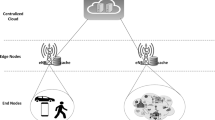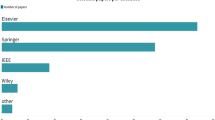Abstract
Widespread availability of network technologies, mobile user request is increased day by day. The larger amount of energy utilization and resource sufficiency of cloud computing is to create the maximum capacity of exploration and exploitation as troublesome. In this paper, we proposed the formation of mobile user behavior based topology and its optimization. During the offloading process, the minimization of response time and the energy consumption is the major goal of this paper. The topology node formations are performed via improved text rank algorithm (ITRA) and neural network (NN) classifiers with Euclidian distance. In this paper, we introduced an effective optimization algorithm of the exploitation whale optimization algorithm (EWOA) and it is the combination of differential evaluation (DE) and whale optimization algorithms (WOA). The offloading process of proposed EWOA produces an optimal outcome of minimized energy consumption and response time. The implementation works of the proposed EWOA are carried out in the VMware platform. The performance of the proposed method is evaluated using different size puzzles, face detection applications, and state-of-art methods. Ultimately, our proposed method produces optimal accuracy and convergence speed with the minimized offloading process.












Similar content being viewed by others
References
Agarwal Y, Jain K, Karabasoglu O (2018) Smart vehicle monitoring and assistance using cloud computing in vehicular ad hoc networks. Int J Transp Sci Technol 7(1):60–73
Alonso-Monsalve S, García-Carballeira F, Calderón A (2018) A heterogeneous mobile cloud computing model for hybrid clouds. Future Gener Comput Syst 87:651–666
Babaeizadeh M, Bakhtiari M, Maarof MA (2014) Authentication method through keystrokes measurement of mobile users in cloud environment. Int J Adv Soft Comput Appl 6(3):94–112
Bashir S, Rauber A (2014) Automatic ranking of retrieval models using retrievability measure. Knowl Inf Syst 41(1):189–221
Cao Z, Zhou P, Li R, Huang S, Wu D (2020) Multi-agent deep reinforcement learning for joint multi-channel access and task offloading of mobile edge computing in industry 4.0. IEEE Int Things J 7:6201–6213
Ciobanu R-I, Nehru C, Pop F, Dobre C, Mavromoustakis CX, Mastorakis G (2019) Drop computing: ad hoc dynamic collaborative computing. Future Gener Comput Syst 92:889–899
Cleveland W, Delvin S (1988) Locally weighted regression: an approach to regression analysis by local fitting. J Am Stat Assoc 83(403):596–610
Das S, Mullick SS, Suganthan PN (2016) Recent advances in differential evolution-an updated survey. Swarm Evol Comput 27:1–30
Fernando N, Loke S, Rahayu W (2001) Mobile cloud computing: a survey. Future Gener Comput Syst 29(1):84–106
Fu Z, Sun X, Linge N, Zhou L (2014) Achieving effective cloud search services: multi-keyword ranked search over encrypted cloud data supporting synonym query. IEEE Trans Consum Electron 60(1):164–172
Gong W, Cai Z (2013) Parameter extraction of solar cell models using repaired adaptive differential evolution. Sol Energy 94:209–220
Gong Y, Zhang C, Fang Y, Sun J (2018) Protecting location privacy for task allocation in ad hoc mobile cloud computing. IEEE Trans Emerg Top Comput 6(1):110–121
Guo X, Sun H, Wang L, Qu Z, Ding W (2015) De-word classification algorithm based on the electric power of large data library retrieval. In: Computer science and its application. pp 591–602
Guo X, Liu L, Chang Z, Ristaniemi T (2018) Data offloading and task allocation for cloudlet-assisted ad hoc mobile clouds. Wirel Netw 24(1):79–88
Haq A, Faheem Y (2020) A peer-to-peer communication-based content distribution protocol for incentive-aware delay tolerant networks. Wirel Netw 26(1):583–601
Hassan BA (2020) CSCF: a chaotic sine cosine firefly algorithm for practical application problems. Neural Comput Appl. https://doi.org/10.1007/s00521-020-05474-6
Hassan BA, Rashid TA (2020) Datasets on statistical analysis and performance evaluation of backtracking search optimisation algorithm compared with its counterpart algorithms. Data in Brief 28:105046
Hassan BA, Rashid TA (2021) A multidisciplinary ensemble algorithm for clustering heterogeneous datasets. Neural Comput Appl. https://doi.org/10.1007/s00521-020-05649-1
Hsu YP, Tu KC, Hsiao CY, Yu SS (2018) The effect of distance function for NN classifier with local binary pattern descriptors. In: International symposium on computer, consumer and control, pp 42–45
Jararweh Y, Jarrah M, Alshara Z, Alsaleh MN (2014) Cloud Exp: a comprehensive cloud computing experimental framework. Simul Model Pract Theory 49:180–192
Jose J, Gautam N, Tiwari M, Tiwari T, Suresh A, Sundararaj V, Rejeesh MR (2021) An image quality enhancement scheme employing adolescent identity search algorithm in the NSST domain for multimodal medical image fusion. Biomed Signal Proc Control 66:102480
Kavitha D, Ravikumar S (2015a) A Survey of different software security attacks and risk analysis based on security threats. Int J Innovat Res Comput Comm Eng 3:3452–3458
Kavitha D, Ravikumar (2015b) Enhanced Vulnerability Analysis For Clickjacking Web Attack And Providing Security Using Whitelisting URL Analyzer. Int J Innovat Res Comput Comm Eng 4(6):12652–12657
Kavitha D, Ravikumar S (2020) Designing an IoT based autonomous vehicle meant for detecting speed bumps and lanes on roads. J Ambient Intell Humaniz Comput. https://doi.org/10.1007/s12652-020-02419-8
Kim IK, Wang W, Humphery M (2017) Empirical evaluation of workload forecasting techniques for predictive cloud resource scaling. In: IEEE 9th international conference on cloud computing, pp 1–10
Kleinbaum DG, Dietz K, Gail M, Klein M, Klein M (2002) Logistic regression. Springer, New York
Kumar K, Lu YH (2010) Cloud computing for mobile users: can offloading computation save energy. Comput Technol 4:51–56
Lacuesta R, Sendra S, Lloret J, Peñalver L (2014) Spontaneous ad hoc mobile cloud computing network. Recent Adv Commun Netw 2014:1–19
Li C, Liu Y, Luo Y (2017) Multimedia cloud content distribution based on interest discovery and integrated utility of user. Comput Ind Eng 109:1–14
Li C, Liye Z, Hengliang T, Youlong L (2019) Mobile user behavior based topology formation and optimization in ad hoc mobile cloud. J Syst Softw 148:132–147
Ling Y, Zhou Y, Luo Q (2017) Levy flights trajectory based Whale Optimization Algorithm for global optimization. IEEE Access 5:6168–6186
Liu D, Fan Z, Fu Q, Li M, Faiz MA, Ali S, Khan MI (2020) Random forest regression evaluation model of regional flood disaster resilience based on the whale optimization algorithm. J Clean Prod 250:119468
Malik SU, Akram H, Gill SS, Pervaiz H, Malik H (2020) EFFORT: energy efficient framework for offload communication in mobile cloud computing. Softw Pract Exp. https://doi.org/10.1002/spe.2850
Michalcea R, Tarau P (2004) Text Rank: bringing order into tests. In: Proceedings of the conference on empirical methods in natural language processing, pp 404–411
Mohammad AL-R, Elham AL-S, Jararweh Y (2015) AMCC: ad-hoc based mobile cloud computing modeling. Proc Comput Sci 56:580–585
Munoz O, Pascual-Iserte A, Vidal J (2015) Optimization of radio and computational resources for energy efficiency in latency-constrained application offloading. IEEE Trans Veh Technol 64(10):4738–4755
Noman N, Iba H (2008) Accelerating differential evolution using an adaptive local search. IEEE Trans Evol Comput 12(1):107–125
Qin AK, Suganthan PN (2005) Self-adaptive differential evaluation algorithm for numerical optimization. Proc IEEE Congr Evol Comput 2:1785–1791
Ravikumar S, Kavitha D (2020) IoT based home monitoring system with secure data storage by Keccak–Chaotic sequence in cloud server. J Ambient Intell Humaniz Comput. https://doi.org/10.1007/s12652-020-02424-x
Rejeesh MR (2019) Interest point based face recognition using adaptive neuro fuzzy inference system. Multimed Tools Appl 78(16):22691–22710
Rejeesh MR, Thejaswini P (2020) MOTF: multi-objective Optimal Trilateral Filtering based partial moving frame algorithm for image denoising. Multimed Tools Appl 79:28411–28430
Riasudheen H, Selvamani K, Mukherjee S, Divyasree IR (2020) An efficient energy-aware routing scheme for cloud-assisted MANETs in 5G. Ad Hoc Netw 97:102021
Saeed MHR, Hassan BA, Qader SM (2017) An optimized framework to adopt computer laboratory administrations for operating system and application installations. Kurdistan J Appl Res 2(3):92–97
Saini TK, Sharma SC (2019) Prominent unicast routing protocols for mobile ad hoc networks: criterion, classification, and key attributes. Ad Hoc Netw 89:58–77
Sarker IH, Colman A, Han J, Khan AI, Abushark YB, Salah K (2020) Behavdt: a behavioral decision tree learning to build user-centric context-aware predictive model. Mobile Netw Appl 25(3):1151–1161
Satyanarayanan M, Bahl P, Caceres R, Davies N (2009) The case for VM-based cloudlets in mobile computing. IEEE Pervas Comput 4:14–23
Sharma S, Chang V, Tim U, Wong J, Gadia S (2016) Cloud-based emerging services systems, Int J Inf Manag 1–12
Sundararaj V (2016) An efficient threshold prediction scheme for wavelet based ECG signal noise reduction using variable step size firefly algorithm. Int J Intell Eng Syst 9(3):117–126
Sundararaj V (2017) Optimized denoising scheme via opposition based self-adaptive learning PSO algorithm for wavelet based ECG signal noise reduction. Int J Biomed Eng Technol 1(1):1
Sundararaj V, Muthukumar S, Kumar RS (2018) An optimal cluster formation based energy efficient dynamic scheduling hybrid MAC protocol for heavy traffic load in wireless sensor networks. Comput Secur 77:277–288
Sundararaj V, Anoop V, Dixit P, Arjaria A, Chourasia U, Bhambri P, Rejeesh MR, Sundararaj R (2020) CCGPA-MPPT: cauchy preferential crossover-based global pollination algorithm for MPPT in photovoltaic system. Prog Photovolt Res Appl 28(11):1128–1145
Tang L, He S, Li Q (2015) Double-sided bidding mechanism for resource sharing in mobile cloud. IEEE Trans Veh Technol 1:99
Uijlings JR, Smeulders AW, Scha RJ (2009) Real-time bag of words, approximately. In: Proceedings of the ACM international conference on image and video retrieval, pp 1–8
Vinu S (2019) Optimal task assignment in mobile cloud computing by queue based ant-bee algorithm. Wirel Pers Commun 104(1):173–197
Walikar GA, Biradar RC (2015) Energy aware multicast routing in mobile ad hoc networks using NS-2. In: IEEE international conference on electrical, computer and communication technologies, pp 1–7
Wang Z, Huang D (2018) Privacy-preserving mobile crowd sensing in ad hoc networks. Ad Hoc Netw 73:14–26
Wang X, Cao J, Liu Y, Gao S, Deng X (2012) Text clustering based on the Improved TFIDFF by the Iterative Algorithm. In: IEEE symposium on electrical and electronics engineering, pp 140–143
Wen Y, Zhang W, Luo H (2012) Energy-optimal mobile application execution: taming resource-poor mobile devices with cloud clones. In: 2012 proceedings IEEE Infocom, pp 2716–2720
Xia F, Ding F, Li J, Kong X, Yang L (2014) Phone2cloud: exploiting computation offloading for energy saving on smartphone’s in mobile cloud computing. Inf Syst Front 16(1):95–111
Yousafzai A, Chang V, Gani A, Moor RM (2016) Directory-based incentive management services for ad hoc mobile clouds. Int J Inf Manag 36(6):900–906
Zeyu X, Qiangqian S, Yijie W, Chenyang Z (2018) Paragraph vector representation based on word to vector and CNN learning. Comput Mater Contin 55(2):213–227
Zhang W, Wen Y, Guan K, Kilper D, Luo H, Wu DO (2013) Energy-optimal mobile cloud computing under stochastic wireless channel. IEEE Trans Wirel Commun 12(9):4569–4581
Zhang H, Wang M, Yang L, Zhu H (2019) A novel user behaviour analysis and prediction algorithm based on mobile social environment. Wirel Netw 25(2):791–803
Zhao T, Zhou S, Song L, Jiang Z, Guo X, Niu Z (2020) Energy-optimal and delay-bounded computation offloading in mobile edge computing with heterogeneous clouds. China Commun 17(5):191–210
Zhou L, Wang H (2013) Toward blind scheduling in mobile cloud: fairness, simplicity and asymptotic optimality. IEEE Trans Multimed 15(4):735–746
Author information
Authors and Affiliations
Corresponding author
Additional information
Publisher's Note
Springer Nature remains neutral with regard to jurisdictional claims in published maps and institutional affiliations.
Rights and permissions
About this article
Cite this article
Anoop, V., Bipin, P.R. Exploitation whale optimization based optimal offloading approach and topology optimization in a mobile ad hoc cloud environment. J Ambient Intell Human Comput 13, 1053–1072 (2022). https://doi.org/10.1007/s12652-021-02945-z
Received:
Accepted:
Published:
Issue Date:
DOI: https://doi.org/10.1007/s12652-021-02945-z




